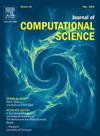用特征稳定混合有限元法对对流主导的对流扩散问题进行了数值研究
IF 3.7
3区 计算机科学
Q2 COMPUTER SCIENCE, INTERDISCIPLINARY APPLICATIONS
引用次数: 0
摘要
本文针对以对流为主的对流扩散问题,提出了一种基于通量低正则性的特征稳定混合有限元法。该方法将特征法与稳定混合有限元法相结合,使用速度和压力的最低等阶对。稳定项基于速度的两个局部高斯积分。此外,我们还得出,压力 u 的近似值在 L2 准则和 H1 准则下是最优的,而速度 p 的近似值在 L2 准则下是次优的。最后,我们给出了二维和三维数值实验来验证理论结果。本文章由计算机程序翻译,如有差异,请以英文原文为准。
A numerical investigation of convection-dominated convection diffusion problems using characteristic stabilized mixed finite element method
In this paper, we propose a characteristic stabilized mixed finite element method based on the lower regularity of the flux for convection dominated convection diffusion problems. The method combines the characteristic method with a stabilized mixed finite element method that uses the lowest equal-order pair for the velocity and pressure. The stabilization term is based on two local Gauss integrations for the velocity. Moreover, we obtain that the approximation of the pressure is optimal in the -norm and -norm, the approximation of the velocity is suboptimal in the -norm. Finally, numerical experiments in 2D and 3D are presented to verify the theoretical results.
求助全文
通过发布文献求助,成功后即可免费获取论文全文。
去求助
来源期刊

Journal of Computational Science
COMPUTER SCIENCE, INTERDISCIPLINARY APPLICATIONS-COMPUTER SCIENCE, THEORY & METHODS
CiteScore
5.50
自引率
3.00%
发文量
227
审稿时长
41 days
期刊介绍:
Computational Science is a rapidly growing multi- and interdisciplinary field that uses advanced computing and data analysis to understand and solve complex problems. It has reached a level of predictive capability that now firmly complements the traditional pillars of experimentation and theory.
The recent advances in experimental techniques such as detectors, on-line sensor networks and high-resolution imaging techniques, have opened up new windows into physical and biological processes at many levels of detail. The resulting data explosion allows for detailed data driven modeling and simulation.
This new discipline in science combines computational thinking, modern computational methods, devices and collateral technologies to address problems far beyond the scope of traditional numerical methods.
Computational science typically unifies three distinct elements:
• Modeling, Algorithms and Simulations (e.g. numerical and non-numerical, discrete and continuous);
• Software developed to solve science (e.g., biological, physical, and social), engineering, medicine, and humanities problems;
• Computer and information science that develops and optimizes the advanced system hardware, software, networking, and data management components (e.g. problem solving environments).
 求助内容:
求助内容: 应助结果提醒方式:
应助结果提醒方式:


